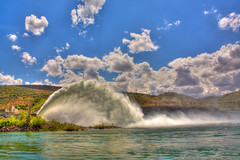Ok, I admit it. When it comes to computers, I am a GEEK. I love computers, I love twiddling with them... and I love playing with software. I think that is kind of why photography speaks to me. I am not an artist. God, I don't have an artistic bone in my body. Luckily, for me, I can at least SEE art, and the camera allows me to capture it.
If you have spent much time at all, with photography, you will know we have something called the Rule of Thirds. With the cameras themselves, we have THREE distinct settings, used to get the proper lighting: ISO, Shutter Speed, and apature. We take into account the fstop for depth of field. We use technology, to capture art. There are artists out there, that create art, then use a camera to capture it. I will freely admit, I am no where CLOSE to that... but I do like the techy aspect of photography. I have learned how to use ISO to squeeze out a bit better shot, but I realize I am giving up a "clean" image. (due to more "grain" or noise). I have figured out how to use neutral density filters to reduce the light going into my camera, so I can take a longer exposure of a water, to make it look silky. I think I have come a long ways. While I used to actively think about these things, now, it is becoming second nature to a degree. (let’s face it, I have only had my dSLR for just under 2 months, and you can only learn SO much in that time...)
So, for my NEXT geeky move, into photography. It is HDR, or High Dynamic Range imaging. This stuff is pretty cool. There are flickr groups dedicated to it. There is software designed for it (Photomatix and High dynamic Photo) and there seems to be a big buzz about it. It is very cool. While our eyes can see something like 11 "fstops" of range, a picture can pull up between 5 and 7. (I have seen both of those numbers listed). So, our eyes can see a LOT more of a scene than a camera. We can see INTO shadows, and pull out detail, while at the same time, looking over at a bright subject, and seeing detail in there. With a camera, one or both would be blown out, or underexposed, to get a picture. Well, with HDR, we take a series of pictures, and blend them into one. This creates some VERY cool effects, and makes for some very rich pictures. (Peruse the HDR flickr group I linked to above, to see just how cool).
For some reason, my geeky friends love this, as do I. It is, on its surface, very simple. I set my camera to auto-bracket. I fire 1 shot at -1 exposure, 1 at the proper exposure and then one more at +1 exposure. Then, I use one of those two softwares above, to merge it into one picture. I know it is FAR more complicated than that, since Photomatix has 2 settings, one is HDR, and one is blending. To me, they are one in the same (at this point in my journey of knowledge), but, since both are options, I know they are ultimately different.
If you are curious about the quality of the software I list, from what I understand, Photomatix is the most popular piece of software. It is supposed to be able to create the most natural looking pictures. While High Dynamic Photo creates good photos as well… its user-interface is MILES better than Photomatix’s. Ultimately, it depends on what you care more about. Oh, and Photomatix is about double the price of HDP. (as an aside, I bought Photomatix today, to start playing with this stuff, and later in the day, learned about HDP. I doubt I would have gone for Photomatix, because of the price, but if you search well with Google, you CAN find a 15% discount on Photomatix, bringing the price down some)
If you have spent much time at all, with photography, you will know we have something called the Rule of Thirds. With the cameras themselves, we have THREE distinct settings, used to get the proper lighting: ISO, Shutter Speed, and apature. We take into account the fstop for depth of field. We use technology, to capture art. There are artists out there, that create art, then use a camera to capture it. I will freely admit, I am no where CLOSE to that... but I do like the techy aspect of photography. I have learned how to use ISO to squeeze out a bit better shot, but I realize I am giving up a "clean" image. (due to more "grain" or noise). I have figured out how to use neutral density filters to reduce the light going into my camera, so I can take a longer exposure of a water, to make it look silky. I think I have come a long ways. While I used to actively think about these things, now, it is becoming second nature to a degree. (let’s face it, I have only had my dSLR for just under 2 months, and you can only learn SO much in that time...)
So, for my NEXT geeky move, into photography. It is HDR, or High Dynamic Range imaging. This stuff is pretty cool. There are flickr groups dedicated to it. There is software designed for it (Photomatix and High dynamic Photo) and there seems to be a big buzz about it. It is very cool. While our eyes can see something like 11 "fstops" of range, a picture can pull up between 5 and 7. (I have seen both of those numbers listed). So, our eyes can see a LOT more of a scene than a camera. We can see INTO shadows, and pull out detail, while at the same time, looking over at a bright subject, and seeing detail in there. With a camera, one or both would be blown out, or underexposed, to get a picture. Well, with HDR, we take a series of pictures, and blend them into one. This creates some VERY cool effects, and makes for some very rich pictures. (Peruse the HDR flickr group I linked to above, to see just how cool).
For some reason, my geeky friends love this, as do I. It is, on its surface, very simple. I set my camera to auto-bracket. I fire 1 shot at -1 exposure, 1 at the proper exposure and then one more at +1 exposure. Then, I use one of those two softwares above, to merge it into one picture. I know it is FAR more complicated than that, since Photomatix has 2 settings, one is HDR, and one is blending. To me, they are one in the same (at this point in my journey of knowledge), but, since both are options, I know they are ultimately different.
If you are curious about the quality of the software I list, from what I understand, Photomatix is the most popular piece of software. It is supposed to be able to create the most natural looking pictures. While High Dynamic Photo creates good photos as well… its user-interface is MILES better than Photomatix’s. Ultimately, it depends on what you care more about. Oh, and Photomatix is about double the price of HDP. (as an aside, I bought Photomatix today, to start playing with this stuff, and later in the day, learned about HDP. I doubt I would have gone for Photomatix, because of the price, but if you search well with Google, you CAN find a 15% discount on Photomatix, bringing the price down some)
Now, lets look at some pictures:

This one was processed with High Dynamic Photo. I had 3 exposures of -1.33/0/+1.33.
 This one was processed with Photomatix. I had 3 exposures of -1.33/0/+1.33.
This one was processed with Photomatix. I had 3 exposures of -1.33/0/+1.33.

This one was processed with Photomatix. I had 3 exposures of -1.33/0/+1.33.
These are a little different. They were blended, but based on one RAW file. I set one to +1 Exposure and one to -1 exposure saved the 2 files, and then combined them. It was more to test it out. The top one, is "blended" the bottom one was combined using HDR.




2 comments:
Yup, it's cool stuff. I was just at a photoshoot for Rolling Stone a couple weeks ago, and the photographer did a simplified version of HDR by layering 2 images with different lighting on top of each other, so that we could get the best lighting on the product from all sides. The only question is how using HDR affects the realism of the scenario. There's a lot of stuff on flickr that's over-enhanced (well, in my opinion - a lot of people seem to like it). Anyway, I always appreciate another photographer's point of view. Thanks for posting!
To me, HDR has two distinct aspects. One, like you saw used, is to pull out different light levels, to get a better over-all shot. (I tihnk, my picture with the white roses up front, and the red ones in back is a good example of that). Then, you have the over processed, like that bright pink rose. The Macro shot of the rose, is the same rose, but I cut WAY down on the processing.
What I find VERY cool about HDR, Tone Mapping, and Exposure Blending, is how many different "effects" you can do to the same picture. By enhancing different aspects of light, you can turn a photograph from blah, to WOW.
On flickr, I have been getting a lot of great comments about that Rose taken with a Macro. Using normal, RAW processing, it really isn't ALL that great. With the added colors, it gives the image more pop, and makes it interesting.
Post a Comment